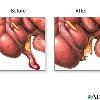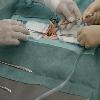

Tags: Appendectomy View |
Tags: Appendectomy View |
Tags: Appendectomy View |
|||||||||
appendectomy (sometimes called appendisectomy or appendicectomy) is the surgical removal (Excision) of the vermiform appendix. This procedure is normally performed as an emergency procedure, when the patient is suffering from acute appendicitis. In the absence of surgical facilities, intravenous antibiotics are used to delay or avoid the onset of sepsis; it is now recognized that many cases will resolve when treated non-operatively. In some cases the appendicitis resolves completely; more often, an inflammatory mass forms around the appendix. This is a relative contraindication to surgery.
Appendectomy may be performed laparoscopic (Laparoscopic surgery)ally (this is called minimally invasive surgery) or as an open operation. Laparoscopy is often used if the diagnosis (medical diagnosis) is in doubt, or if it is desirable to hide the scars in the umbilicus (Navel) or in the pubic hair line. Recovery may be a little quicker with laparoscopic surgery; the procedure is more expensive and resource-intensive than open surgery and generally takes a little longer, with the (low in most patients) additional risks associated with pneumoperitoneum (inflating the abdomen with gas). Advanced pelvic sepsis occasionally requires a lower midline laparotomy.
In general terms, the procedure for an open appendectomy is as follows.
#Antibiotics are given immediately if there are signs of sepsis, otherwise a single dose of prophylactic intravenous antibiotics is given immediately prior to surgery. #General anaesthesia is induced, with endotracheal intubation (endotracheal tube) and full muscle relaxation (Muscle relaxant), and the patient is positioned supine (supine position). #The abdomen is prepared and draped and is examined under anesthesia. #If a mass is present, the incision is made over the mass; otherwise, the incision is made over McBurneys point, one third of the way from the anterior superior iliac spine (ASIS) and the umbilicus; this represents the position of the base of the appendix (the position of the tip is variable). #The various layers of the abdominal wall are then opened. #The effort is always to preserve the integrity of abdominal wall. Therefore, the External Oblique Aponeurosis is slitted along its fiber, and the internal oblique muscle is split along its length, not cut. As the two run at right angles to each other, this prevents later Incisional hernia. #On entering the peritoneum, the appendix is identified, mobilized and then ligated and divided at its base. #Some surgeons choose to bury the stump of the appendix by inverting it so it points into the caecum. #Each layer of the abdominal wall is then closed in turn. #The skin may be closed with staples or stitches. #The wound is dressed. #The patient will be brought to the recovery room.



